How to use JSON type fields in MySQL
Test environment: MySQL8.0.19
Preparation
CREATE TABLE json_demo (
`id` INT ( 11 ) NOT NULL PRIMARY KEY,
`content` json NOT NULL
);
INSERT INTO json_demo ( id, content )
VALUES
/*这条是数组*/
( 1, '[{"key": 1, "order": 1, "value": "34252"},{"key": 2, "order": 2, "value": "23423"}]' ),
/*这条是数组*/
( 2, '[{"key": 4, "order": 4, "value": "234"},{"key": 5, "order": 5, "value": "234324523"}]' ),
/*这条是对象*/
( 3, '{"key": 3, "order": 3, "value": "43242"}' ),
/*这条是对象*/
( 4, '{"key": 6, "order": 6, "value": "5423"}' );JSON object basic operation
Query the specified field value
/* 基础查询 */ SELECT content -> '$.key' AS 'key', JSON_EXTRACT(content, '$.key') AS 'key2', content -> '$.value' AS 'value', JSON_EXTRACT(content, '$.value') AS 'value2', content ->> '$.value' AS 'value3', JSON_UNQUOTE(JSON_EXTRACT(content, '$.value')) AS 'value4' FROM json_demo WHERE id > 2;
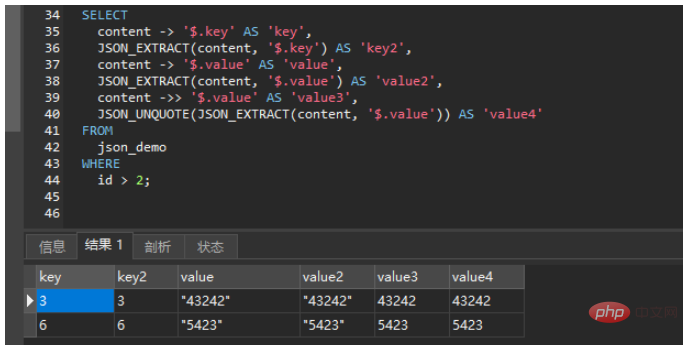
TIPS:
- ##-> and ->> are the syntax designed by MySQL , among which -> is supported in MySQL5.7, and ->> is supported in MySQL8.0.
- -> Equivalent to JSON_EXTRACT(), when the query field is a string, the return value will also have "".
- ->> Equivalent to JSON_UNQUOTE(JSON_EXTRACT()), when the query field is a string, the return value will not have "".
Used for conditional query
content -> '$.key' can be regarded as a field, and the operations that can be performed on a field are basically He can do it.SELECT id, content -> '$.key' AS 'key', content ->> '$.value' AS 'value3' FROM json_demo WHERE id > 2 AND content -> '$.key' > 1 AND content -> '$.value' like '%2%';
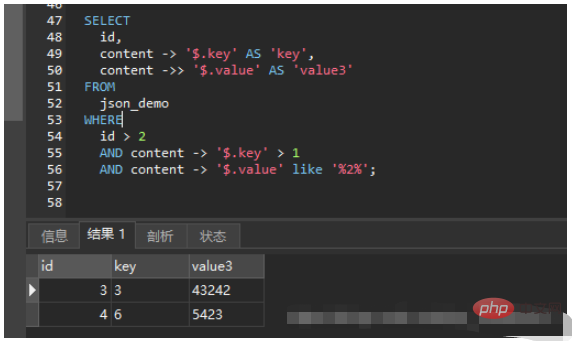
/* 修改 */ UPDATE json_demo SET content = JSON_REPLACE( content, /* 将content.key值 + 1 */ '$.key', content -> '$.key' + 1, /* 将content.value值后拼接'abc' */ '$.value', concat(content ->> '$.value', 'abc') ) WHERE id = 3; /* JSON_SET也可以 */ UPDATE json_demo SET content = JSON_SET( content, /* 将content.key值 + 1 */ '$.key', content -> '$.key' + 1, /* 将content.value值后拼接'abc' */ '$.value', concat(content ->> '$.value', 'abc') ) WHERE id = 3; /* 查询修改结果 */ SELECT id,content,content -> '$.key' AS 'key',content ->> '$.value' AS 'value3' FROM json_demo WHERE id = 3; /* 重新赋值 */ UPDATE json_demo SET content = JSON_REPLACE(content,'$.key',3,'$.value','43242') WHERE id = 3;
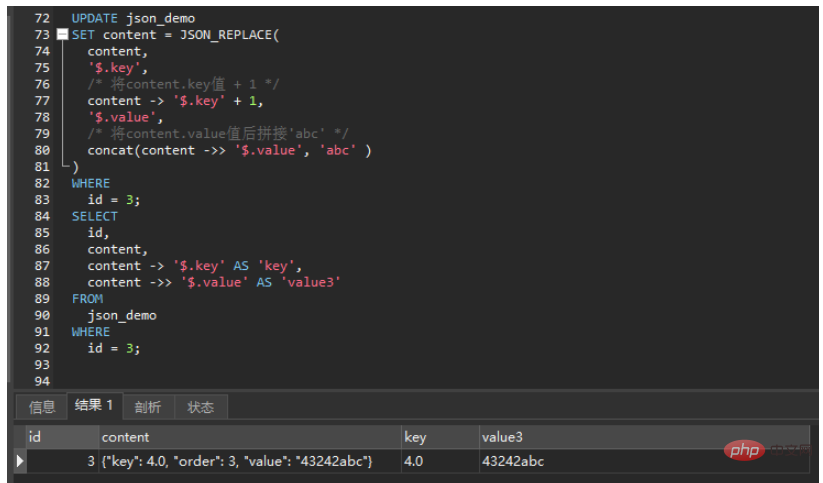
TIPS:
- Both JSON_REPLACE and JSON_SET can be used to modify the value of a certain field. The difference is that when JSON_REPLACE replaces a non-existent attribute, the operation is invalid; while JSON_SET will insert the non-existent attribute.
- So JSON_SET can also be used to append attributes, similar to JSON_INSERT. The difference is that JSON_INSERT operation will fail if an existing attribute is inserted, while JSON_SET will replace it.
Append elements
UPDATE json_demo SET content = JSON_INSERT(content, '$.key', 234) WHERE id = 3; SELECT id,content,content -> '$.key' AS 'key' FROM json_demo WHERE id = 3; UPDATE json_demo SET content = JSON_INSERT(content, '$.temp', 234) WHERE id = 3; SELECT id,content,content -> '$.key' AS 'key' FROM json_demo WHERE id = 3; UPDATE json_demo SET content = JSON_SET(content, '$.temp2', 432) WHERE id = 3; SELECT id,content,content -> '$.key' AS 'key' FROM json_demo WHERE id = 3;
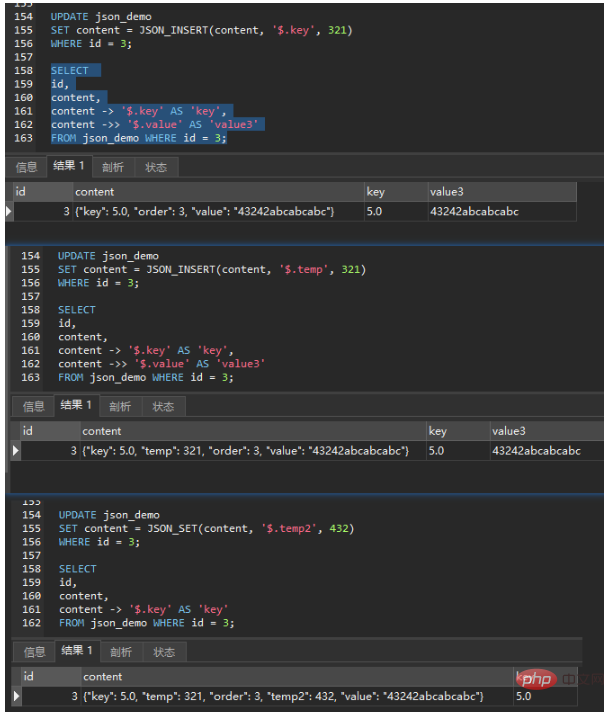 ##JSON array operation
##JSON array operation
SELECT
id,
content -> '$[*].key' AS 'key',
content ->> '$[*].value' AS 'value',
content -> '$[0].key' AS 'key2',
content ->> '$[0].value' AS 'value2',
/* 查询数组长度 */
JSON_LENGTH(content) AS 'length'
FROM
json_demo
WHERE
id < 3;
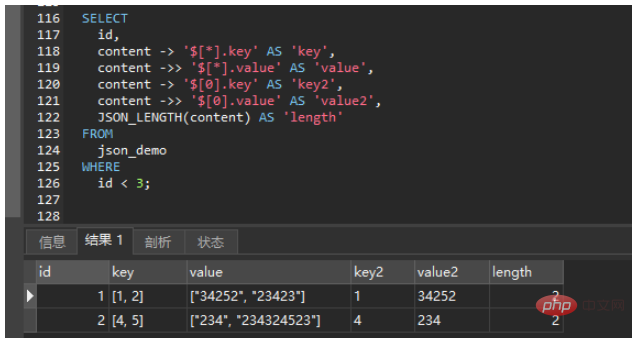
The basic operations are not much different from the JSON object, that is, add the corresponding index bit '$[0]' after '$', and specify all '$[*] '. If the array contains an array, you can specify the deep array elements through '$[1][2][3]'. Both JSON_ARRAY_APPEND and JSON_ARRAY_INSERT can append array elements. The difference is that JSON_ARRAY_APPEND does not need to specify the index bit, in which case it will be appended to the last position; JSON_ARRAY_INSERT must specify the index bit, and an error will be reported if not specified. JSON_ARRAY_APPEND is appended after the specified index bit, while JSON_ARRAY_INSERT is inserted in front of the specified index bit. The above is the detailed content of How to use JSON type fields in MySQL. For more information, please follow other related articles on the PHP Chinese website!SELECT
id,
content -> '$[*].key' AS 'key',
content ->> '$[*].value' AS 'value'
FROM
json_demo
WHERE
id < 3
/* content.value的值中存在like'%34%'的值 */
AND content ->> '$[*].value' like '%34%'
/* content.key的值中有4 */
AND JSON_OVERLAPS(content ->> '$[*].key', '4' );
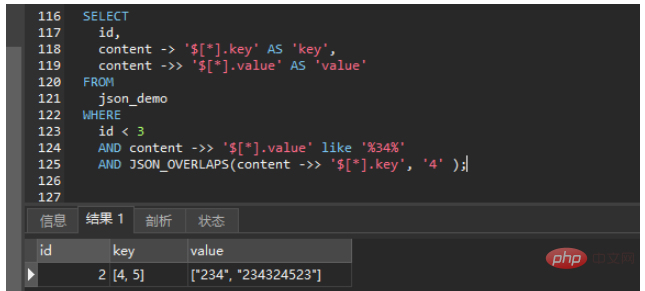
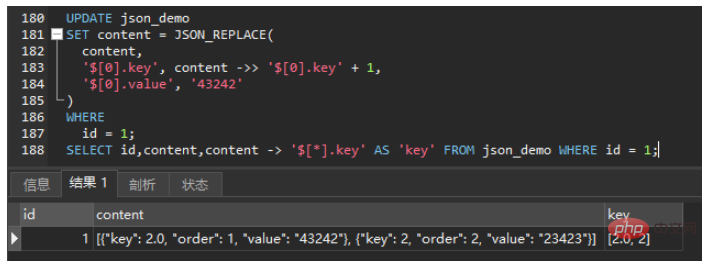
More operations
Name
Description
JSON_ARRAY()
Create a JSON array
JSON_ARRAY_APPEND()
Append data to a JSON document
##JSON_ARRAY_INSERT( )
Insert into JSON array
JSON_CONTAINS()
Whether the JSON document contains a specific object in the path
JSON_CONTAINS_PATH()
Whether the JSON document contains any data in the path
JSON_DEPTH()
The maximum depth of the JSON document
JSON_EXTRACT()
Return data from JSON document
JSON_INSERT()
Insert data into JSON document
JSON_KEYS()
Key array in JSON document
JSON_LENGTH()
In JSON document Number of elements
JSON_MERGE() (deprecated)
Merge JSON documents, retaining duplicate keys. Deprecated synonyms for JSON_MERGE_PRESERVE()
JSON_MERGE_PATCH()
Merge JSON documents, replacing values for duplicate keys
JSON_MERGE_PRESERVE()
Merge JSON documents, retaining duplicate keys
JSON_OBJECT() Create JSON object
JSON_OVERLAPS() (Introduced in 8.0.17)
Compares two JSON documents and returns TRUE (1) if they have any key-value pairs or array elements in common, otherwise returns FALSE (0)
JSON_PRETTY() ##JSON_QUOTE()Print JSON document in an easy-to-read format
JSON_REMOVE() Reference JSON document
JSON_REPLACE()Remove data from JSON document
JSON_SCHEMA_VALID() (Introduced in 8.0.17) Replace values in JSON documents
JSON_SCHEMA_VALIDATION_REPORT() (Introduced in 8.0.17) Validate JSON documents against the JSON schema; if the document is validated against the schema, then Returns TRUE/1; otherwise, returns FALSE/0.
JSON_SEARCH()Validates a JSON document against a JSON schema; returns a report on the validation results in JSON format, including success or failure and failure Reason
The path of the value in the JSON document
##JSON_SET() will Data inserted into JSON document
JSON_STORAGE_FREE() Free space in binary representation of JSON column value after partial update
JSON_STORAGE_SIZE() The space used to store the binary representation of the JSON document
JSON_TABLE() Returns data from a JSON expression as Relational table
JSON_TYPE() JSON value type
JSON_UNQUOTE() Dereference JSON Value
JSON_VALID() Whether the JSON value is valid Extracts a value from the JSON document at the location pointed to by the supplied path; returns this value as VARCHAR (512) or the specified type
##JSON_VALUE() (introduced in 8.0.21)
Returns true (1) if the first operand matches any element of the JSON array passed as the second operand, false (0) otherwise
MEMBER OF() (8.0.17 Introduced)

Hot AI Tools

Undresser.AI Undress
AI-powered app for creating realistic nude photos

AI Clothes Remover
Online AI tool for removing clothes from photos.

Undress AI Tool
Undress images for free

Clothoff.io
AI clothes remover

AI Hentai Generator
Generate AI Hentai for free.

Hot Article

Hot Tools

Notepad++7.3.1
Easy-to-use and free code editor

SublimeText3 Chinese version
Chinese version, very easy to use

Zend Studio 13.0.1
Powerful PHP integrated development environment

Dreamweaver CS6
Visual web development tools

SublimeText3 Mac version
God-level code editing software (SublimeText3)

Hot Topics
 1382
1382
 52
52
 MySQL: Simple Concepts for Easy Learning
Apr 10, 2025 am 09:29 AM
MySQL: Simple Concepts for Easy Learning
Apr 10, 2025 am 09:29 AM
MySQL is an open source relational database management system. 1) Create database and tables: Use the CREATEDATABASE and CREATETABLE commands. 2) Basic operations: INSERT, UPDATE, DELETE and SELECT. 3) Advanced operations: JOIN, subquery and transaction processing. 4) Debugging skills: Check syntax, data type and permissions. 5) Optimization suggestions: Use indexes, avoid SELECT* and use transactions.
 How to open phpmyadmin
Apr 10, 2025 pm 10:51 PM
How to open phpmyadmin
Apr 10, 2025 pm 10:51 PM
You can open phpMyAdmin through the following steps: 1. Log in to the website control panel; 2. Find and click the phpMyAdmin icon; 3. Enter MySQL credentials; 4. Click "Login".
 MySQL: An Introduction to the World's Most Popular Database
Apr 12, 2025 am 12:18 AM
MySQL: An Introduction to the World's Most Popular Database
Apr 12, 2025 am 12:18 AM
MySQL is an open source relational database management system, mainly used to store and retrieve data quickly and reliably. Its working principle includes client requests, query resolution, execution of queries and return results. Examples of usage include creating tables, inserting and querying data, and advanced features such as JOIN operations. Common errors involve SQL syntax, data types, and permissions, and optimization suggestions include the use of indexes, optimized queries, and partitioning of tables.
 Why Use MySQL? Benefits and Advantages
Apr 12, 2025 am 12:17 AM
Why Use MySQL? Benefits and Advantages
Apr 12, 2025 am 12:17 AM
MySQL is chosen for its performance, reliability, ease of use, and community support. 1.MySQL provides efficient data storage and retrieval functions, supporting multiple data types and advanced query operations. 2. Adopt client-server architecture and multiple storage engines to support transaction and query optimization. 3. Easy to use, supports a variety of operating systems and programming languages. 4. Have strong community support and provide rich resources and solutions.
 How to use single threaded redis
Apr 10, 2025 pm 07:12 PM
How to use single threaded redis
Apr 10, 2025 pm 07:12 PM
Redis uses a single threaded architecture to provide high performance, simplicity, and consistency. It utilizes I/O multiplexing, event loops, non-blocking I/O, and shared memory to improve concurrency, but with limitations of concurrency limitations, single point of failure, and unsuitable for write-intensive workloads.
 MySQL and SQL: Essential Skills for Developers
Apr 10, 2025 am 09:30 AM
MySQL and SQL: Essential Skills for Developers
Apr 10, 2025 am 09:30 AM
MySQL and SQL are essential skills for developers. 1.MySQL is an open source relational database management system, and SQL is the standard language used to manage and operate databases. 2.MySQL supports multiple storage engines through efficient data storage and retrieval functions, and SQL completes complex data operations through simple statements. 3. Examples of usage include basic queries and advanced queries, such as filtering and sorting by condition. 4. Common errors include syntax errors and performance issues, which can be optimized by checking SQL statements and using EXPLAIN commands. 5. Performance optimization techniques include using indexes, avoiding full table scanning, optimizing JOIN operations and improving code readability.
 MySQL's Place: Databases and Programming
Apr 13, 2025 am 12:18 AM
MySQL's Place: Databases and Programming
Apr 13, 2025 am 12:18 AM
MySQL's position in databases and programming is very important. It is an open source relational database management system that is widely used in various application scenarios. 1) MySQL provides efficient data storage, organization and retrieval functions, supporting Web, mobile and enterprise-level systems. 2) It uses a client-server architecture, supports multiple storage engines and index optimization. 3) Basic usages include creating tables and inserting data, and advanced usages involve multi-table JOINs and complex queries. 4) Frequently asked questions such as SQL syntax errors and performance issues can be debugged through the EXPLAIN command and slow query log. 5) Performance optimization methods include rational use of indexes, optimized query and use of caches. Best practices include using transactions and PreparedStatemen
 How to recover data after SQL deletes rows
Apr 09, 2025 pm 12:21 PM
How to recover data after SQL deletes rows
Apr 09, 2025 pm 12:21 PM
Recovering deleted rows directly from the database is usually impossible unless there is a backup or transaction rollback mechanism. Key point: Transaction rollback: Execute ROLLBACK before the transaction is committed to recover data. Backup: Regular backup of the database can be used to quickly restore data. Database snapshot: You can create a read-only copy of the database and restore the data after the data is deleted accidentally. Use DELETE statement with caution: Check the conditions carefully to avoid accidentally deleting data. Use the WHERE clause: explicitly specify the data to be deleted. Use the test environment: Test before performing a DELETE operation.




